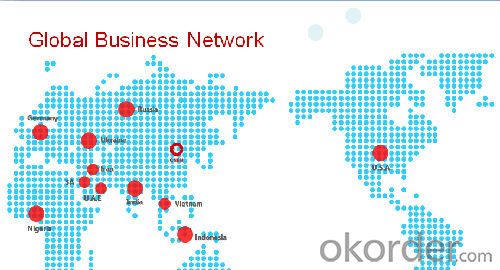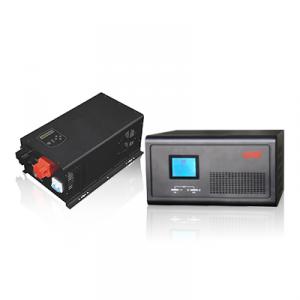Pure Sine Wave Inverter Home Inverter 600-3500W
- Loading Port:
- China main port
- Payment Terms:
- TT or LC
- Min Order Qty:
- 100 pc
- Supply Capability:
- 1000 pc/month
OKorder Service Pledge
OKorder Financial Service
You Might Also Like
| Home Inverter 600-3500W |
Home Inverter 600W-3500W is Pure sine wave output inverter which are specially used for house appliance such as TV, refrigerator, fan, air conditioner etc, and also it can be used as UPS for computers. That means It can supply power to various loads such as resitive load, inductive load, motors and rectifier load. It is equipped with programmable big current, 3 stages battery charger (10-70Amp adjustable charger) to run 10hrs longer backup time. |
● Reliable, Durable and Economical Power for Grid and Mobile Applications
● Microprocessor based Inverter / Charger provides
● Ultra-clean pure sine wave output with less than 5% total harmonic distortion
● Supply energy to various loads such as resistive load, inductive load, motors and rectifier load.
● Control panel with large LCD
● Powerful 300% surge power
● Low sleep mode power consumption of less than 5W
● Phase & frequency synchronization auto-tracing for seamless transfer time
● Programmable big current, 3 stages battery charger
● Long backup time up to 10 hours (based on the battery bank and loads).
● Easy to install, easy to maintain, and built for years of reliable service
Q. How long the UPS to run when power goes?
This can take 3 paths.
1.You can pick a UPS that is rated for pretty much the full VA you need so it will be running at 100% of capability and will thus last 'n' minutes.
2.You can pick a UPS that is rated at a much higher VA value than you really need so, for example, is running at 50% of capability and will thus last for longer than the UPS from option 1.
3.You can use extra external battery packs to run for longer. If charging capability allows, the more and the bigger batteries you take with, the longer time UPS runs.
or using a generator after about 6 hours, it will be more cost-effective, with a short runtime UPS to bridge the generator start-up gap.Q. What's lifetime of a UPS ?
Most plug-in UPS are workable for at least five years. We'd advise you to change the batteries every three to four years. For larger equipment, we maintain equipment for twenty years old and still going strong.
Q. How to maintain a UPS ?
There are three simple methods: Never overload your UPS, never connect any home electronic devices such as cooling fan to your UPS. This may cause malfunction of your UPS. Discharge the battery in a consistent interval, once a month or once two months. You can do this by turning on the UPS without connecting the mains.


- Q:How does a three-phase solar inverter differ from a single-phase inverter?
- A three-phase solar inverter differs from a single-phase inverter in terms of the number of phases they support. While a single-phase inverter is designed to work with a single-phase electrical system, a three-phase solar inverter is specifically designed to handle three-phase electrical systems. This means that a three-phase inverter can handle higher power loads and is more efficient in distributing power across the three phases, resulting in better overall performance and stability for three-phase electrical systems.
- Q:What is the maximum number of parallel inverters that can be connected?
- The maximum number of parallel inverters that can be connected depends on various factors such as the power rating, capacity, and design of the inverters, as well as the electrical system they are being connected to. It is best to consult the manufacturer's specifications and guidelines to determine the maximum number of parallel inverters that can be safely connected.
- Q:How do you choose the right voltage rating for a solar inverter?
- When choosing the right voltage rating for a solar inverter, it is important to consider a few factors. First, you need to determine the voltage of your solar panel array. This will help you match the inverter's voltage rating to ensure compatibility. Additionally, you should consider the voltage requirements of your electrical grid or any appliances you plan to power. The inverter's voltage rating should align with these requirements to ensure efficient energy conversion and safe operation. It is advisable to consult with a professional or an electrical engineer to help you select the appropriate voltage rating for your solar inverter based on your specific needs and system setup.
- Q:Can a solar inverter be used with different grid voltages?
- No, a solar inverter cannot be used with different grid voltages. Solar inverters are designed to convert the DC power generated by solar panels into AC power that matches the specific voltage and frequency of the grid. Using a solar inverter with different grid voltages can cause damage to the inverter and can also be a safety hazard.
- Q:Can a solar inverter work during a power outage?
- No, a solar inverter cannot work during a power outage unless it is specifically designed with a backup power supply or battery storage system.
- Q:What are the typical efficiency ranges for different types of solar inverters?
- The typical efficiency ranges for different types of solar inverters vary depending on the specific technology and design. However, in general, string inverters have an efficiency range of around 95% to 98%, while microinverters tend to have an efficiency range of about 96% to 99%. On the other hand, central inverters have a wider efficiency range, typically ranging from 95% to 99%. It's important to note that these efficiency ranges can also be influenced by factors such as temperature, load, and design variations among manufacturers.
- Q:How does a solar inverter handle harmonic distortion?
- A solar inverter handles harmonic distortion by incorporating filters and control algorithms that help mitigate and minimize harmonics in the system. These filters are designed to reduce harmonic current injection into the grid, ensuring compliance with power quality standards. Additionally, advanced control algorithms continuously monitor the inverter's output waveform and adjust its operation to reduce harmonic distortion and maintain clean power generation from the solar panels.
- Q:Can a solar inverter be used with both AC and DC power sources?
- No, a solar inverter is designed to convert DC power from solar panels into AC power for use in standard electrical systems. It cannot be used with both AC and DC power sources simultaneously.
- Q:What is the role of a solar inverter in maintaining system stability?
- The role of a solar inverter in maintaining system stability is to convert the direct current (DC) electricity generated by solar panels into alternating current (AC) electricity that can be used in homes or fed back into the electrical grid. The inverter also ensures that the output voltage and frequency of the AC electricity are within acceptable limits, allowing for seamless integration with the existing power grid. By regulating and stabilizing the electricity flow, the solar inverter helps maintain the overall stability and reliability of the solar power system.
- Q:What are the potential risks of overcharging a battery connected to a solar inverter?
- Overcharging a battery connected to a solar inverter can lead to several potential risks. One of the primary risks is a reduced lifespan of the battery. Overcharging can cause excessive heat and stress on the battery, leading to a shorter overall lifespan and reduced capacity over time. Another risk is the potential for thermal runaway or battery failure. Overcharging can cause the battery to become unstable, leading to a build-up of gases and potential leakage or explosion. Furthermore, overcharging can also result in increased maintenance costs. The battery may require frequent monitoring and maintenance to prevent overcharging, which can be time-consuming and costly. Lastly, overcharging can lead to inefficient energy storage. When a battery is overcharged, excess energy is wasted, reducing the overall efficiency of the solar energy system. To mitigate these risks, it is crucial to properly size and configure the solar inverter and battery system, ensuring that the battery is not subjected to excessive charging currents. Using appropriate charge controllers and monitoring systems can also help prevent overcharging and protect the battery from potential risks.
1. Manufacturer Overview |
|
|---|---|
| Location | |
| Year Established | |
| Annual Output Value | |
| Main Markets | |
| Company Certifications | |
2. Manufacturer Certificates |
|
|---|---|
| a) Certification Name | |
| Range | |
| Reference | |
| Validity Period | |
3. Manufacturer Capability |
|
|---|---|
| a)Trade Capacity | |
| Nearest Port | |
| Export Percentage | |
| No.of Employees in Trade Department | |
| Language Spoken: | |
| b)Factory Information | |
| Factory Size: | |
| No. of Production Lines | |
| Contract Manufacturing | |
| Product Price Range | |
Send your message to us
Pure Sine Wave Inverter Home Inverter 600-3500W
- Loading Port:
- China main port
- Payment Terms:
- TT or LC
- Min Order Qty:
- 100 pc
- Supply Capability:
- 1000 pc/month
OKorder Service Pledge
OKorder Financial Service
Similar products
New products
Hot products
Hot Searches
Related keywords































